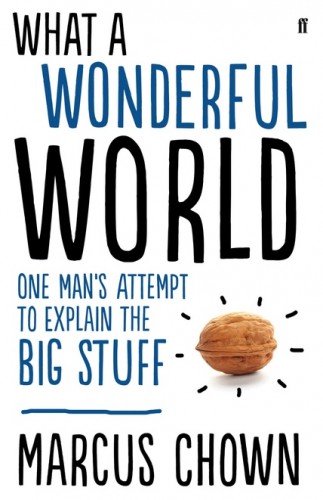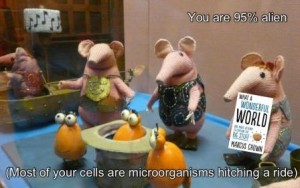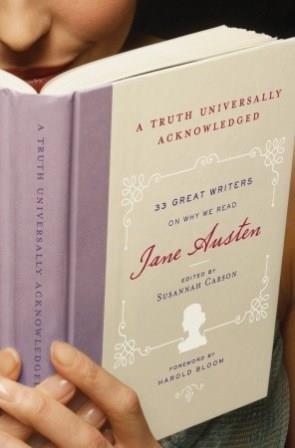
Until very recently, I refused to join Twitter; I didn’t understand the point of it but knew that I already lost enough precious time to the lure of the Internet.
Now, I’m a convert. Not only is it a great source of book-related links, but it turns out that it can be a source of actual books. Alright, one book: I am the very pleased owner of an ARC of Marcus Chown’s ‘What a Wonderful World’.
What’s it about?
The sub-title sums this book up rather nicely. It is ‘one man’s attempt to explain the big stuff‘ which includes, but is definitely not limited to, how the brain works, why life reproduces sexually rather than asexually and why is there something rather than nothing.
The scope is very broad and Chown explains in his foreword that this book exists in part because his publisher set him a challenge. His speciality is physics: he is currently cosmology advisor to New Scientist magazine and his book ‘We need to talk about Kelvin’ was short listed for the 2010 Royal Society Book Prize. However, Chown isn’t just interested in physics; he’s interested in everything, so why not write about…everything?
humans are one third mushroom, age more slowly on the ground floor of a building and have brains that are actually between 5-10% smaller than our Cro-Magnon ancestors
Along the way Chown reveals that humans are one third mushroom, age more slowly on the ground floor of a building and have brains that are actually between 5-10% smaller than our Cro-Magnon ancestors. He also explains why, in a lucid and accessible manner.
What’s it like?
Fascinating. Perplexing. Furrowed-brow-inducing.
I feel at once more and less knowledgeable as a result of having read this. While reading, my school science lessons flitted through my mind, so some of the material felt slightly familiar, but then Chown would move on to more complex or unfamiliar ideas and my head would spin a little. Ok, it spun a lot. I was reassured by his inclusion of a quote from Niels Bohr: ‘If anybody says he can think about quantum physics without getting giddy, that only shows he has not understood the first thing about it.’ I was very giddy, so I must have understood most some of it…right?
Although the publicity material makes this book sound a bit like a QI compendium – and there is certainly a wide range of amusing facts – this isn’t a beach book or a toilet book: it demands your concentration. (At least, that was my justification for settling down with it, a cup of tea and a biscuit and resolutely ignoring all housework when my baby was napping.)

We are born 100% human but die 95% alien.
At the end of each chapter I felt like I wanted to pause and reflect to really absorb what I had learned. Typically, the little details stuck, rather than the bigger picture, so I can tell you why mouth-to-mouth resuscitation works (exhaled breath still contains 20% oxygen) but not why the entire universe may be a hologram (??!)
‘My skill is that I can take complex physics and explain it to someone on a number 25 bus (or perhaps I should say someone unfortunate enough to be sitting next to me on a number 25 bus).’
Chown has an engaging style which helps to make the topics covered accessible and entertaining. This is useful as there are no pictures at all. Personally, I would have found diagrams useful at a couple of points, but perhaps that would have made the book feel too academic – it is aimed at readers without specialist knowledge. Instead, Chown cultivates a chatty style, using italics to emphasise key points in his explanations, asking questions to develop issues and making liberal use of informal discourse markers. This all combines to make complicated topics easy to read about, yet he never patronises his readers.
No book is perfect and, to me, the chapter on money felt slightly out of place in this book. In contrast to every other chapter, it felt under-researched (an impression supported by the comparative lack of references) and unscientific. However, it was still very interesting, especially Chown’s scary conclusions about the nature of the financial market.
Final thoughts
So does the book deliver what it promises? Absolutely. This is a well-referenced, clear and interesting set of explanations of the way the world works. Helpfully, each chapter can be read discretely, although this does mean there is some repetition throughout.
So does the book deliver what it promises? Absolutely.
Chown’s strength is his ability to make or reference analogies, using a range of comprehensible similes and metaphors, which make even the really complex ideas move into focus. Although I struggled on occasion to follow the ideas to their conclusion, I felt that this was the fault of my sleep-deprived, non-mathematically minded brain rather than a flaw on the part of the author or the book. After all, it’s not his fault that the Answer isn’t simply 42.
Rather than discrete chunks of new knowledge, I suspect what will stick with me from reading this book is the sheer sense of wonder expressed in the title and infused throughout the chapters. Chown often comments on how unlikely we are. Even the milky way shouldn’t really exist, never mind contain a planet with exactly the right conditions to sustain oxygen-based life forms, including an ape-like species evolved enough to question its own existence. I am left with a pleasant sense that life is a wondrous thing, which I will try to remember next time it seems to be a bit of a bitch.
And another thing
This post forms part of a blog tour so you should see plenty about this book over the coming weeks. Specifically, you’ll find more stuff tomorrow here.
You can also find out more about Marcus Chown here.


